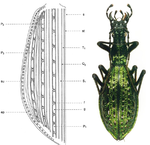Abstract
Members of large genus Carabus (Insecta, Coleoptera, Carabidae) show ornamental and conspicuously diverse morphological sculptures on the surfaces of their elytrae. Origin and significance of these sculptures is unknown. Theories usually explain emergence of such structures as a result of sexual selection or as an adaptation to environment, but almost never as an outcome of neutral evolution.
We explore the latter two possibilities by analyzing the relationship between morphospace of elytral sculptures of 1,177 sub-species of genus Carabus and environmental variables across the whole Palaearctic, while taking into account spatial and evolutionary autocorrelation. We used principal coordinates analysis (PCoA) to identify two main axes of variability in elytral morphospace (20 morphological traits) and we also classified the sub-species according to the homogeneity of morphological elements.
We used the fourth-corner method, generalized linear models and variation partitioning to assess if the morphology is driven by environmental conditions, by spatial autocorrelation, and/or by evolutionary relatedness. We found two main axes of morphological variability which separated the sub-species according to elytral grain size and distinctness of the grains. These axes and also the homogeneity of morphological elements correlated weakly with climate. However, when we accounted for the spatial component and evolutionary relatedness there was nearly no independent effect of environment on elytral sculptures.
Our results indicate that morphological variability of the sculptures is not influenced by environmental factors and we hypothesize that, at continental scales, the elytral ornaments of genus Carabus are an outcome of environmentally unconstrained neutral evolution—something that has been rarely demonstrated in empirical study. A surprising by-product of our study is the finding that sub-species within the genus Carabus have an extremely high degree of endemicity which highlights the conservation value of the group.
